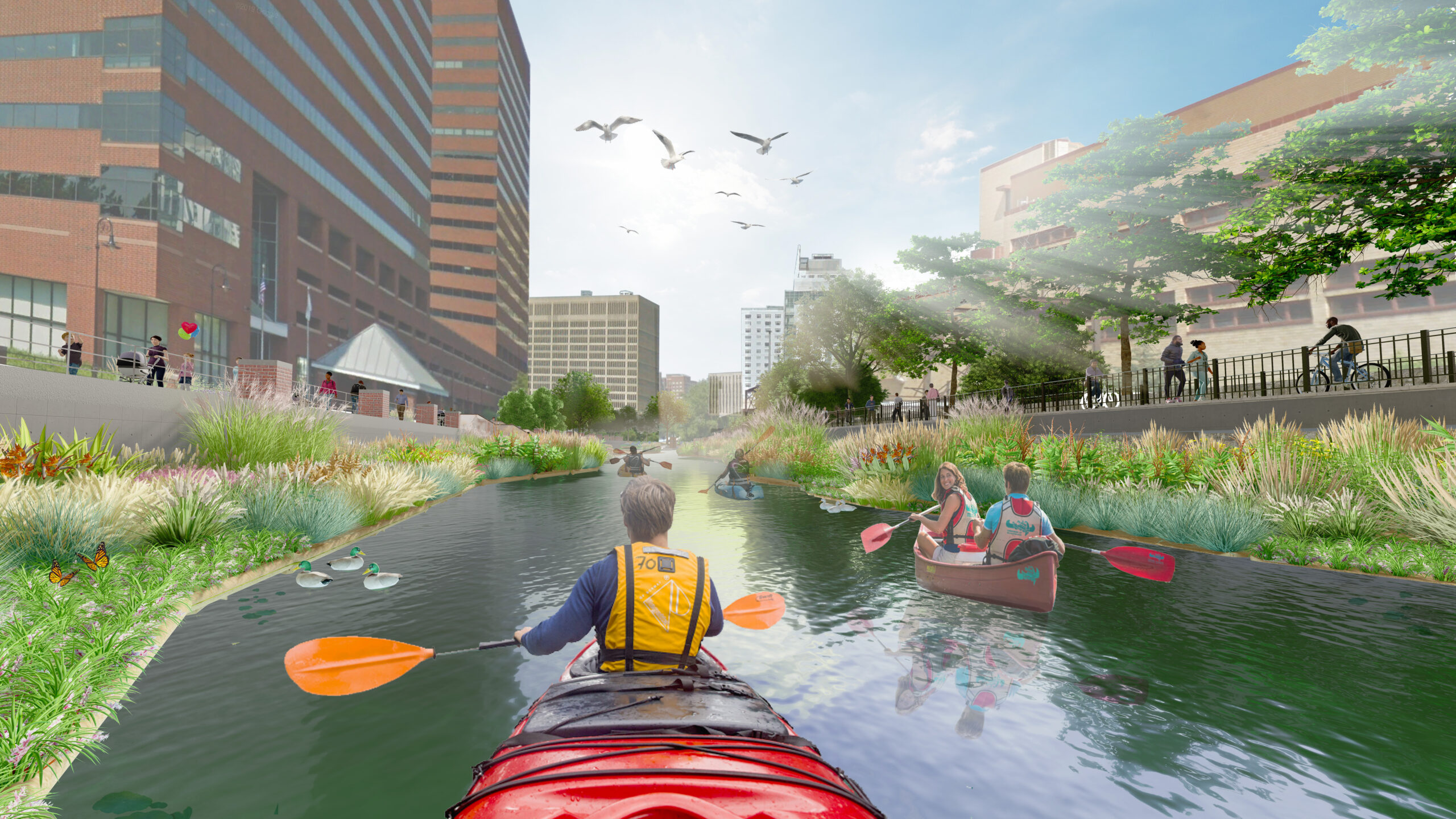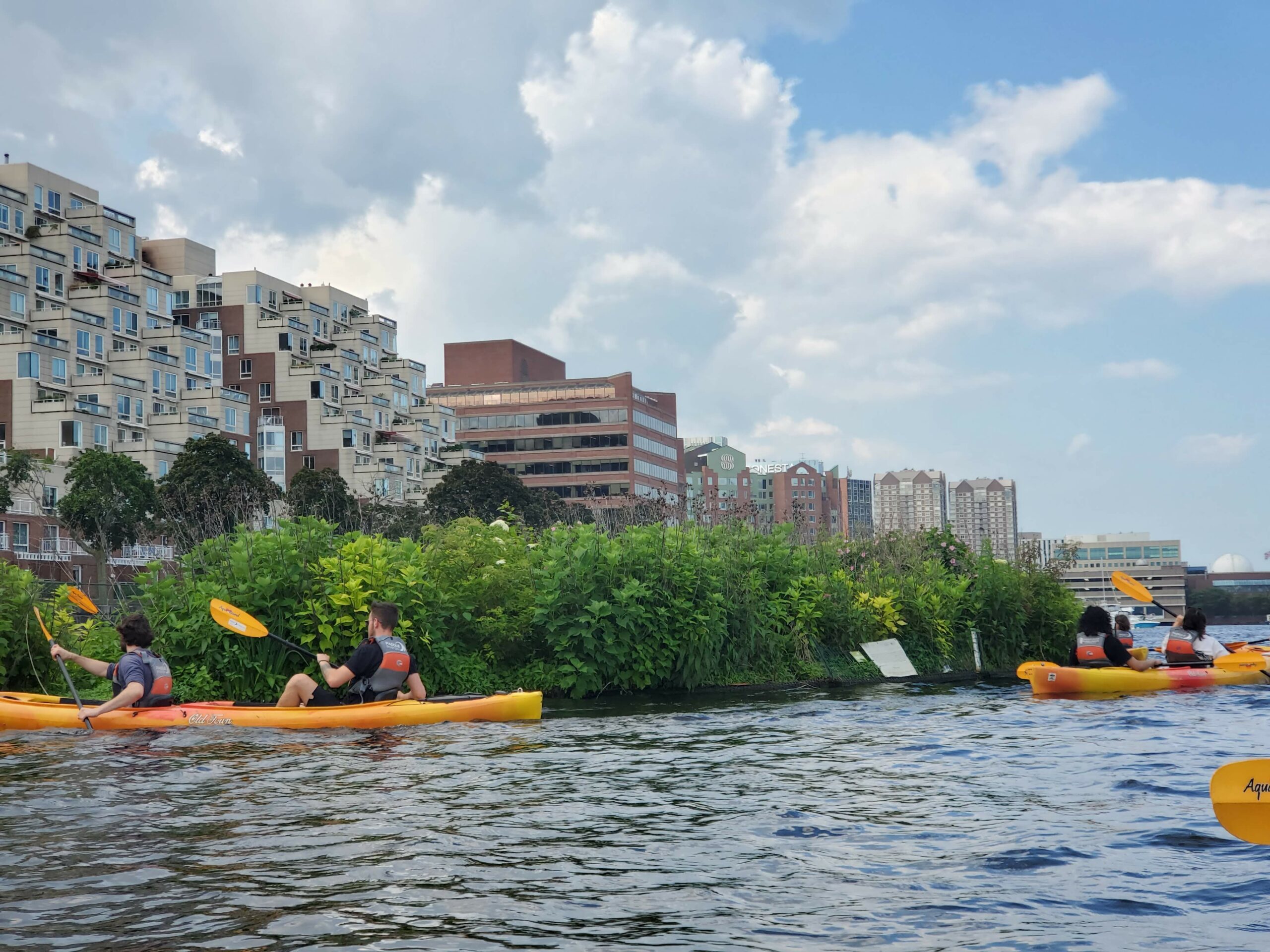If you’ve kayaked near the Broad Canal, biked along the Cambridge Parkway, or ridden the Red Line train over the Charles, chances are you have caught a glimpse of a green patch in the middle of the river. This is a floating wetland: an artificial, self-buoyant island that provides a surface for plants to grow and allows their roots to extend into the water. Now imagine the Broad Canal lined with floating wetlands for people to see and touch up close. This vision for more floating wetlands is possible. The Charles River’s first floating wetland was spearheaded by the Charles River Conservancy (CRC), a nonprofit organization with a mission to make the Charles River and its parks a well-maintained network of natural urban places that invite and engage all in their use and stewardship. The CRC installed the pilot floating wetland near the Longfellow Bridge in Cambridge in partnership with the Massachusetts Department of Conservation and Recreation. The project explores how floating wetlands may benefit water quality and the local ecology. With promising findings from a 3-year research study, positive reception from the community, and strong stakeholder support, the CRC is eager to embark on the next phase of this project and expand at Kendall Square’s Broad Canal.

Challenges Confronting the Charles River
Salt marshes and wetlands serve crucial roles in the natural world, absorbing storm surges, providing native habitats to support biodiversity, and filtering water. However, the Charles River and many other urban water bodies, wetlands, and natural shorelines have been reduced or eliminated, eroding these benefits. Nutrient pollution is a particular problem since the urban landscape has many sources of pollution and fewer opportunities for natural filtration before they reach the water. Climate change exacerbates this situation because more irregular but heavier rainfalls capture more pollution and tax existing infrastructure systems, allowing more pollution to enter the river. This excess of nutrients (known as eutrophication) creates an imbalance that drastically alters the food chain and can cause public health concerns, such as harmful algal blooms (cyanobacteria).
A New Tool to Support a Healthier River
In-stream tools are needed to achieve healthier water bodies. While it is essential to reduce the number of pollutants (by removing sources), increase on-land opportunities for filtration (such as rain gardens), and lower and treat stormwater runoff (by updating infrastructure like sewers and outfalls), limitations imposed by existing development and landscape require that in-stream tools also be part of the solution.
To address this need, the CRC began the Charles River Floating Wetland initiative to expand the nature-based tools available to support climate resilience, advance ecological health, combat pollution, and empower the community to understand and be part of the solutions. Our first phase was installed in 2020: a pilot of ~700 square feet that adds native wetland plants to a section of the river where seawalls and hardscaped land have replaced shorelines. The project seeks to understand how adding these systems may improve the ecosystem’s ability to self-regulate urban pressures by:
- Removing nutrients from the water through absorption by the plants.
- Providing additional habitat for zooplankton, which can be efficient grazers of cyanobacteria.
- Increasing biodiversity by providing new habitat in a largely hardscaped section of the river.
A research program (with partner Northeastern University) gathered critical data to understand how the wetland impacts the local ecology and how larger installations could have a meaningful impact and help public and private landowners meet regulatory targets for reducing nutrient pollution towards a healthier Charles River.

Envisioning the Future
The CRC has identified Kendall Square’s Broad Canal as an ideal potential site for the next stage of the Charles River Floating Wetland initiative based on three years of data collected from the pilot, input gathered from permitting and advocacy stakeholders, youth and community feedback, and best practices gleaned from national peer projects.
The Broad Canal is an excellent location for a floating wetland “park” since it is one of the first places where cyanobacteria blooms occur. Initial research shows that ~1 acre of floating wetlands can have the capacity to offset 100% of phosphorus of a 6.8-acre area. Floating wetlands along its walls could offset phosphorus runoff, provide additional access to the river, pull in passersby exploring Cambridge, and support a connected community.
Community Connections
The Charles River Floating Wetland is an invaluable tool for engagement, providing access to outdoor environmental education and community outreach opportunities. While the wetland was still in the design phase and for each season since installation, the CRC has connected with the community virtually, in classrooms, on field trips, and (possibly the most exciting) – on the water!
Each summer, the CRC hosts kayak tours that engender conversations about the wetland’s science, community desires, and feedback to install more wetlands. Kayak trips provide a new means of accessing and experiencing the river for youth and many adults. By partnering with local community groups, the CRC provides youth with a glimpse into environmental and landscape design professions, the opportunity to observe the growth and vitality of the plants, explore community perspectives, and understand water pollution’s impacts.
The Charles River Floating Wetland has brought hundreds of community members to the water over the last three years. Imagine the meaningful impact more wetlands could provide to the community and the river. The CRC continues to work towards this vision for more floating wetlands by centering community engagement, feedback, and access as its priorities to ensure that a “floating park” on the Charles meets the needs of river science, place, and people.
Visit the Charles River Conservancy’s website to learn more about the project and how you can support the expansion. Read the Charles River Floating Wetland Report for more in-depth information detailing the project from idea to installation and engagement through envisioned development.